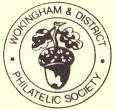13th June 2023 - Aspects of China - Paul Davey
Members of the Society were treated to a show by visiting presenter Paul Davey covering numerous aspects of China. This began with the early Imperial government letter system known as the I Chan. Large envelopes in blue were accompanied by a Journey Form listing the date, time and condition at every stop.

Non-governmental mail was carried by Min Hsin Chu, commercial letter carriers. In China, Letter Hongs or Min Hsin Chus existed for hundreds of years. It was the only way an ordinary citizen would be able to send a letter until the formation of the National Post Office on Chinese New Year Day, 2nd February 1897. These small companies worked together to cover the Chinese empire.
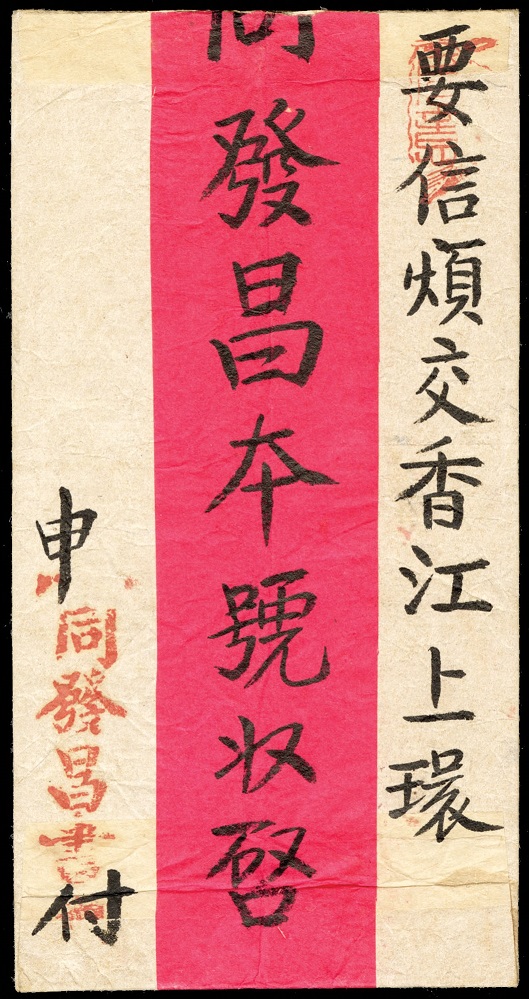
The next frame showed perfins and firm's security markings of Imperial China, followed by two frames of the first definitive set produced in Taiwan following its return to China in 1945. These were produced by overprinting stamps produced by the Japanese but never issued. The final two frames of the first half showed Imperial cancellations, missent mail, Wei Hai Wei and a cover from Shanghai to The Times in London that was detained in Paris during WWII.

The second half showed Commemoratives until WWII and two frames of early Communist China. This included stamps found in most "kid's" collections but with varieties, an unissued stamp (according to SG) used on a parcel post form, and an unlisted $50 double print.
Chairman Mark Bailey gave a vote of thanks for a most interesting display, and presented Paul with a Certificate of Appreciation.
8th November 2022 - Members' Displays on the theme of Wildlife
In the absence of the Chairman, proceedings were overseen by Deputy Chairman Susan Greenwood.
Patrick Reid was first up with a display of stamps from Tasmania featuring the Duck-billed Platypus. The platypus in Tasmania is distinct from that found in mainland Australia.

Trevor Cornford showed a wide range of wildlife, predominantly on postcards, but also stamps. These included Lions, Giraffes, Tigers, Elephants, Pythons, Kangaroo, Crocodile, Sealions, Polar Bears, Sea Elephants, Walrus, and more. He also included a penguin stamp on cover postmarked "Fox Bay" in the Falkland Islands, and showed stamps featuring animal head trophies and the Dodo.
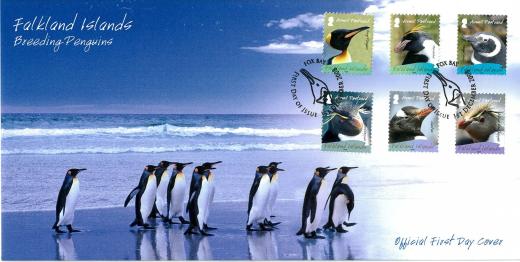
David Walker displayed eagles of various types and included 1844 forgeries featuring the American Eagle.
Eric Holmes showed a selection of bird stamps featuring birds seen by him during his travels around the world. He also regaled the members with stories about his bird-watching trips, notably to the Scilly Isles and to South America.
Michael Curling had brought along stamps and covers featuring wildlife, including a selection from North Borneo, some Western Australia Swans and other swans, also Cormorants and Puffins, and a label with a Kingfisher, Mouse and Dragonfly. Finally Michael showed some corals.
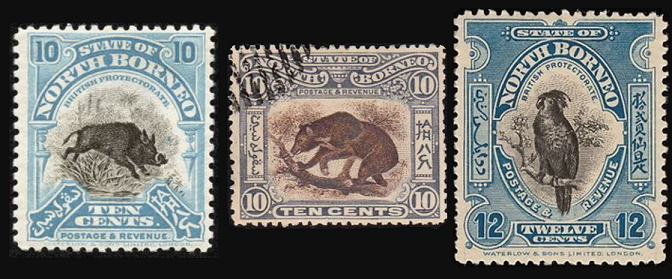
Derek Steele displayed a range from all over the world including Swans from Sweden and a book of wildlife stamps extracted from the stamps that were in the late David Gerken's garage.

Susan Greenwood thanked all who had shown material.
9th August 2022 - The Life and Times of King George VI 1895 to 1952 - Daphne McMillan FRPSL
Daphne McMillan's display is based on a five-frame Open Class Exhibit.
The first part covered the period up to the King's Coronation in 1937. It opened with the Newfoundland Coronation set of 1911 that Daphne used to illustrate the Royal family tree.
Prince Albert attended Britannia Royal Naval college, Dartmouth, but apparently was not very good academically. Edward VII had little use for Osborne House and gave it to the nation. It was repurposed as the Junior Naval College.
We saw a letter from Princess Victoria (daughter of King Edward VII), a registered letter that accompanied a 1911 Coronation medal and a letter about a (somewhat hated) female French tutor. The whole display was enhanced by a range of King George VI portrait cards.
Prince Albert served in the Navy and was aboard HMS Collingwood at the Battle of Jutland. However, he was not a good sailor and suffered from gastric problems.

The display included a page on Prince John (the forgotten Prince) followed by a letter from Queen Mary and one from Louis Mountbatten. It was noted that Queen Mary was very skilled at acquiring items that she liked on social visits.
A series of postcards showed Prince Albert's wedding to Elizabeth (Bowes-Lyon).

A trip to Australia to open the Parliament in Canberra in 1927 improved the Prince's confidence.
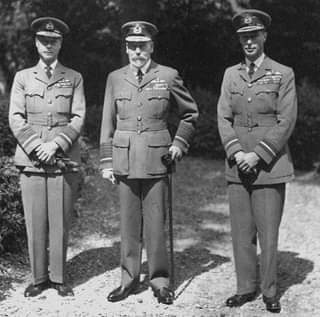

1936 was the year of three Kings. We were shown souvenirs from the Coronation of Edward VIII that never happened, and a cover dated 10th December 1936, the day of his Abdication.
The first part of the display closed with a collection of postcards illustrating the 1937 Coronation, a stamp signed by Edmund Dulac (designer) and a Coronation Programme.

Daphne opened the second part of the display with the Royal Tour to Paris that had been delayed by the death of Lady Strathmore, the Queen's mother. It was noted for the introduction of mauve and white for mourning clothes. On 19 July 1938, the King and Queen crossed the Channel on the British Admiralty Yacht Enchantress and were welcomed to Boulogne and to France by M Georges Bonnet, the Minister for Foreign Affairs. The remainder of the journey to Paris was by train where they were met at the Bois de Boulogne station by President Lebrun and the Prime Minister, Edouard Daladier. This trip was followed by visits to Canada and the United States of America.
A section covering the period of the Second World War noted the travels of all members of the Royal Family to keep up morale. We were shown a registered envelope addressed to, and redirected by, Queen Mary.
The post-war tour to South Africa was hard work for a King who did not enjoy good health. During this tour, Princess Elizabeth was given a necklace with 21 diamonds as a 21st Birthday present.
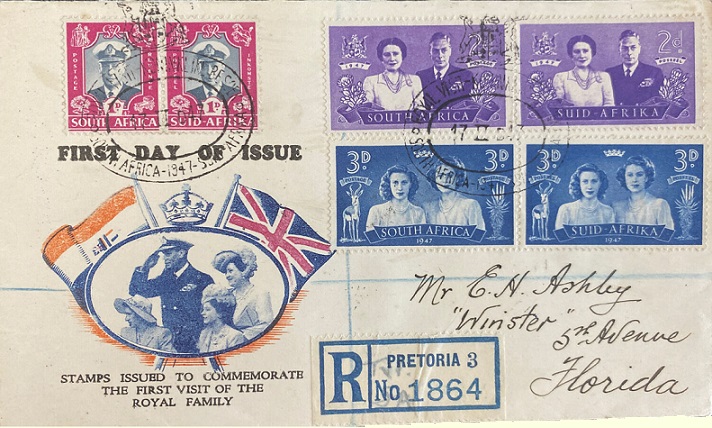
We were shown a souvenir of the Royal Silver wedding (1948) followed by a page about the Festival of Britain (1951) that included some unadopted essays.
Daphne finished her display with two frames on the death of the King on 6th February 1952. The King suffered from lung cancer. Although it was thought that he was recovering, he did not.
Mark Bailey gave the vote of thanks on behalf of the Society and presented Daphne with a Certificate of Appreciation
26th July 2022 - Annual General Meeting
At the Annual General Meeting, the Officers of the Society presented their reports, and a small number of changes to the Society's rules and the Packet rules were adopted.
Mark Bailey stepped down as the Society's President, and Patrick Reid was elected as the President. The election of the Officers of the Society and the Committee took place, with the following result:
- Chairman: Mark Bailey
- Deputy Chairman: Susan Greenwood
- Hon. Secretary: Patrick Reid
- Hon. Treasurer: Chris Rayner
- Hon. Packet Secretary: Derek Steele
- Hon. Membership Secretary: Chris Rayner
- Committee members: Alastair Nixon, Roger Sammons, and Rodney Smith.
It was noted that with the death of two of the former Committee members, there are some unfilled Committee positions.
12th July 2022 - A Philatelic History of the GB 1890 Penny Postage Jubilee - John Davies FRPSL
Our speaker this evening was John Davies, well-known for his work promoting Youth Philately through Stamp Active. He is equally well-known for his superb award-winning display "A Jubilee Reminiscence", on which topic he has also written a book.
John's display covered the events that celebrated the 50th Anniversary of the Penny Black. He had been attracted to the subject by material he bought at the London 1990 philatelic event and he illustrated the problem faced by some recipients of letters in the early part of the 19th century with an item charged at 8/4d. The Penny Black was introduced in 1840 and by 1890 the Post Office was handling 2 million letters a day.
A show held at the Guildhall in London was not the first to celebrate the Anniversary. There had been a show in Austria beforehand, that featured competitive entries and reprinted stamps in multiple colours that were shown by John. Also, before the show, De la Rue had invited competitive essays for commemorative stamps, but this idea was rejected on cost grounds, However, John showed us some unadopted essays.

The Guildhall exhibition was held over three days in May 1890 (Friday/Saturday and Monday). John displayed a full-size plan of the exhibition as well as the reduced version used in his exhibit. This was followed by an invitation that bore a Penny Black lettered VR/JL (Victoria Regina/Jubilee London). The opening was attended by the Prince of Wales, who arrived about 10.30 pm after all the speeches had finished!
At the show, stamps printed from the original 1d dies were shown. There were also an Army Post Office as used in the Sudan, and an operational Post Office and Sorting Office with all the usual labels in use. John noted that the Post Office sold Postal Orders and Money Orders, and that telegraphs could be sent. He further noted that only 37 Registered items were sent.
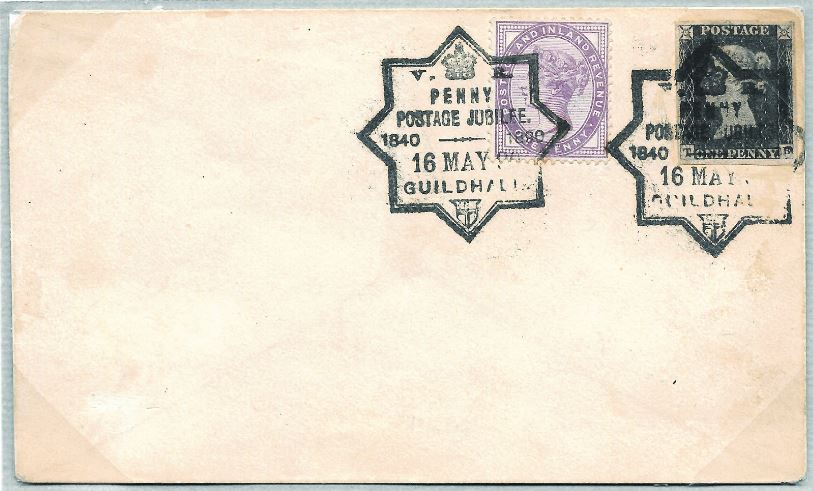
An item that John bought from a fellow collector yielded unexpected bounty. When he opened the cover he found a Telegraph to Rowland Hill's niece and the only recorded example of Telegraph Punched Tape from the Exhibition.
A stationery card was printed for the exhibition. The first printing of 10,000 sold out within three hours. A further 1,500 were then printed. There were two different cancels, one metal, one rubber.
The Jubilee Postal Conversazione in Scotland was held in Edinburgh as part of the International Exhibition of Electrical Engineering, General Inventions and Industries. This opened on 1st May 1890, and continued until 1st November. It was proposed to hold a Jubilee Postal Conversazione in commemoration of the Uniform Penny Postage within the Exhibition on 7th October 1890 but this idea was abandoned.
The second part of John's display was devoted to a further show organised by the Post Office at the Kensington Museum (now the back part of the Victoria & Albert Museum). This was opened by the Duke and Duchess of Edinburgh. Items displayed were similar to the Guildhall, but on a smaller scale. John showed photographs of the interior.

A major attraction was the "Electrophonoscope", purported to be able to do video calls. After the show it was revealed that it was (literally) all done by mirrors! The show also featured a vacuum tube system where messages could be sent and replied to. Only two replies are known to have survived.
There were around 200 Registered items from the show which also featured a fully operational telegraph.Special cachets and postmarks were used, and the Minute Book of the Show Committee confirms that a special envelope was produced. John showed the many steps from Concept and Design through to full Production. The envelopes were sold at 1/- each, with the 11d going to the Rowland Hill Benevolent Fund, which raised the equivalent of £2M for charity.
We were also shown examples of usage followed by forgeries of the envelopes. A further envelope appeared on the Saturday that had been registered (as a design) by William Penney Elliot. It was sufficiently like the original that Elliot was taken to task, and John showed his grovelling letter of apology. Evidently, he got off scot free.
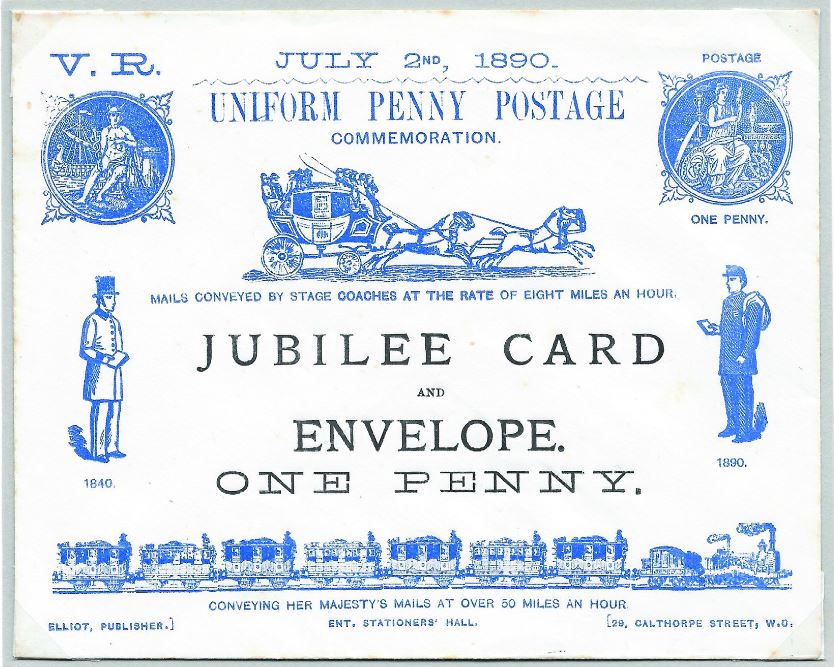
Patrick Reid thanked John for an excellent display. Each time he saw it he learned something new. He presented John with a Certificate and the usual token of our appreciation.
28th June 2022 - GB Protective Overprints and Underprints - Andy Donaldson FRPSL
Our speaker Andy Donaldson began by explaining that he had been collecting underprints and overprints since he found his first one by chance on a Penny Red plate at age 13. A lot of his interest has been in trying to identify the firms (as many only used the firm's initials) and to find out something about these, mostly long gone, companies. His display is as much a social history as it is a postal history display.
Before the advent of the Postal Order, it was the custom of many people to pay small bills in postage stamps and the Post Office facilitated this practice by buying back unused and crucially "undamaged" stamps at face value. These protective overprints and underprints were the precursor to the better known perfins (the Sloper method of perforating stamps with a firm's initials) and served the same purpose, namely to deter theft of the postage stamps by employees, as once marked in this way they could no longer be sold back to the Post Office.
In the Victorian period, more than fifty firms marked stocks of their stamps in this way, mostly unofficially via handstamps or by employing the services of a local printer. The underprints were on top of the gum, meaning survival rates are low. However, there was also an official underprints service from 1866, carried out by the stamp printers Perkins, Bacon & Co. These being printed under the gum consequentially have higher survival rates. Only five firms or organisations took up this service and it was withdrawn in 1882.
Andy's display consisted of examples from most of the firms recorded as having used these underprints and overprints, including many rare examples and, in some cases, items believed to be unique. Essays, official printing warrants (issued by the Stamp Department of the Inland Revenue to Perkins, Bacon & Co.) and an array of ephemera were also on show on a side table.
This warrant shown below is one of 4 examples in the display and one of less than a dozen recorded in private hands. This warrant requests the printing of the J. & C. Boyd & Co. underprint on 100 sheets of the Penny Red.

The 1½d plate 1 stamp with error of lettering OP-PC for CP-PC is a well-known and sought-after variety. The example shown here is one of only two recorded with the official Copestake, Moore, Crampton & Co. underprint.

Andy explained that underprint covers are generally very scarce. The one shown here from Naylor, Benzon & Co. in London has the underprint on both the pair of 3d rose and the 1d red paying the late fee and is one of only two underprint covers recorded for the firm.

This J T and S overprint (for Joseph Travers & Sons) is an essay on a mint 1d red plate 90 from an original block of four. The whereabouts of the other three is unknown.
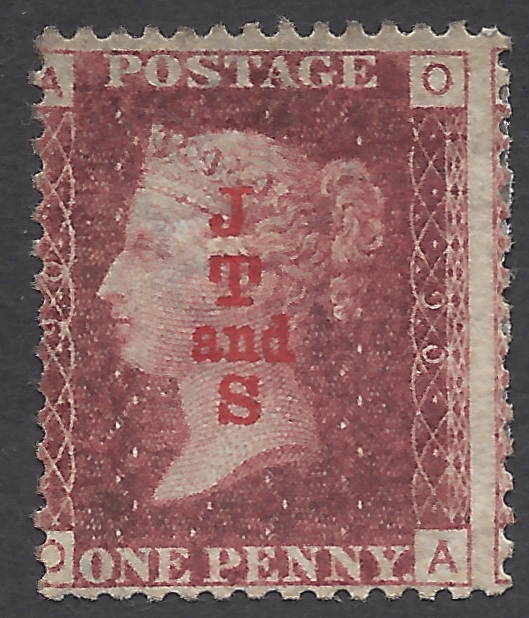
10th May 2022 - Danzig "Luposta 1932" The Greatest Airmail Exhibition ever! - Giles du Boulay
This evening we were entertained by Giles du Boulay who brought us Danzig Luposta 1932 which he referred to as "The Greatest Airmail Exhibition ever". It ran from 23rd to 31st July 1932 and the highlight was a double visit by the airship Graf Zeppelin.
The idea came after the Paris Air Show in 1930-31. Danzig was desperate to promote tourism to help it to pay its share of reparations after the First World War. To put the visit of the Graf Zeppelin in context, they had to pay the equivalent of £156,000 today just for the Zeppelin to call.
The minority (5%) of Danzig's population was Polish, and they were not keen on the event. There is little Polish mail arising from the event, and they urged a boycott of the event.

There was a wealth of philatelic material generated for the event, including Cinderellas, Postal Stationery and slogan cancels. There was even a special Lottery. We were shown examples of letters from the Organising Committee to various places around the world, and letters of response that were deliberately philatelic.
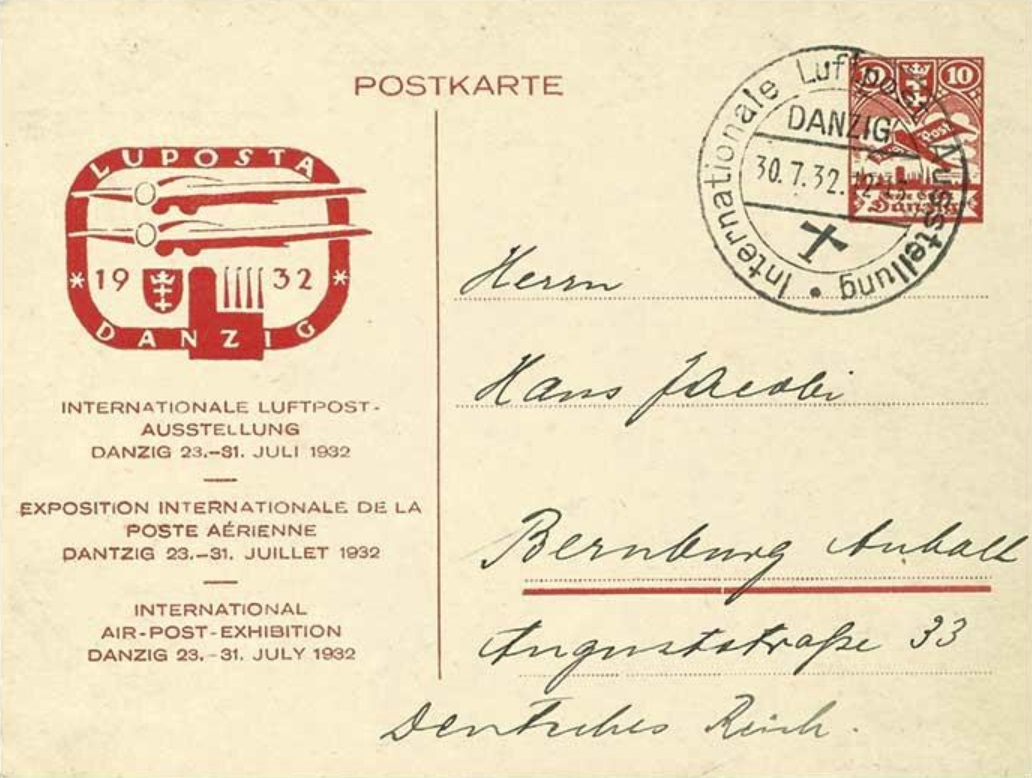
The stamps, issued on 11th July 1932, were based on the current (German) high value definitive stamps. 52,000 sets were suitably overprinted Luftpost-Ausstellung 1932. Problems with printing were apparently fixed using a wax pencil. A booklet was presented to VIPs containing four of each stamp, and it is very rare. There was also a First Day Cover, which is scarce.

The Dornier DOX seaplane visited before the show (a picture of it showed that it had twelve engines) and it carried souvenirs on board.

The Exhibition itself was held in a Franciscan Monastery. Unfortunately all archives were lost during World War Two. The exhibition featured Airmail stamps exhibited by other countries, possibly in albums. Gold, Silver, and Bronze medals were struck to commemorate the Exhibition.

The Exhibition also featured an Aerobatic Display and the ascent of a Montgolfier Balloon. There was a "Balloon Race" for children, who attached labels to balloons to see how far they would travel. Three surviving labels are known. There was also a homing pigeon race, timed to cross the airfield at the right time on Children's Day.
There were Post Offices at both the Exhibition and the Airport where the stamps were sold at twice face value for charity. There was a catalogue for a special Luposta sale. Marshals had a special armband (we were shown a picture of one) and a ticket was required for the Zeppelin enclosure.
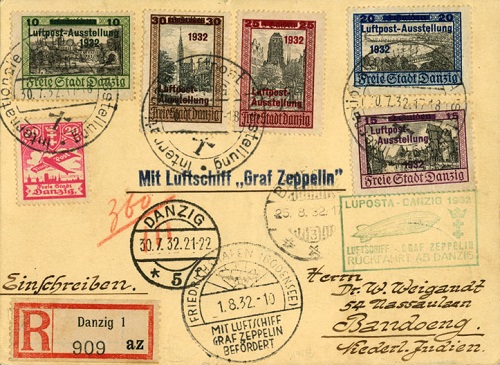
On the last day there was a "Star" car rally, and we were shown a special badge for this.
After the usual refreshment break, Giles resumed his display with a section devoted to the last day of the show, which was the day of the Zeppelin visits. The Zeppelin came up from Friedrichshafen (avoiding the airspace of the Polish Corridor), landed and reloaded and took off for a tour of the Baltic where mail was dropped over Bornholm and it then returned to Danzig and landed. It took off again to return to Friedrichshafen. There were special cachets for the mail on each flight. A scheduled pickup at Duivendorf was missed because of bad weather. It was noted that Capt. Lehmann who piloted the Zeppelin subsequently died in the Hindenburg disaster.
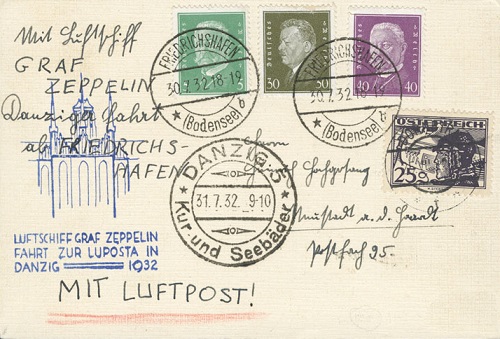
We were shown a menu card from the Zeppelin, signed by the steward, and a wide range of mail from multiple sources including special Postal Stationery. Most frankings are correct. Two unusual items shown were mail from Latvia and a special "Nutley Memorial Card" prepared to remember Ian Nutley who also collected this material.
Other items shown included cards signed by the Jury, Harmers, and the Zeppelin crew. Combination items that went on various flights including Catapult mail to New York, tickets of the casino, and a foolscap size Zeppelin ticket for a Jury member.

Our Chairman Patrick Reid thanked Giles for his excellent and engrossing display, which included a wide range of relevant material that helped to bring Luposta to life for the audience.
26th April 2022 - Haiti - Geoff Hanney FRPSL
Our visiting speaker was Geoff Hanney FRPSL, who presented the story of Haiti.
Although the island was discovered by Columbus, it was claimed by France. The indigenous tribes were ravaged by European diseases and the French took over the running of the island and some became very rich.
The population became a mix of Britons, French Coloureds and half-castes. In 1791 there was a Revolution against French rule. Independence was declared in 1802 but fighting lasted until 1804 when, through a mix of disease and battle, the French lost and were expelled or massacred.
The French had established a mail system around the 1780s, and a series of straight-line cancels is known; to date 72 have been identified. Much mail was sent to the King of France, who apparently discarded it on arrival, so surviving items are rare.
The British had their own Post Office in Jacmel from 1830 and in Port au Prince from 1865. Mail was sent to St Thomas to pick up the regular packet. The French established an agency from 1865.
The literacy of the population was low, and most surviving mail is ship letters.
In 1881 Haiti joined the UPU and issued its first stamps. The inaugural issue for Haiti was a six stamp imperforate set with "Liberty Head" as the design. This was the first and last design that imitated the "French" model, as the rest of the issues for the next 25 years either had "Coat of Arms" with the palm tree design or Presidents as the image. These were imperf and there are many shades.

Plating was done by the distinguished Australian philatelist Bill Purves. Later printings from the same plate were perforated. Postal stationery was available but sold with a stamp affixed.
The Liberty Head stamps were issued in 1882 with 1, 2 and 3 cent values. The later 2, 7 and 20 cent values were forged, possibly by the French.

There was a further Revolution in 1888, and the country split into two factions under General Legitime and General Hyppolite. President Louis Étienne Salomon was overthrown by General Legitime, who installed himself as President, and one year later he was overthrown by General Hyppolite who installed himself as President for a seven-year term.
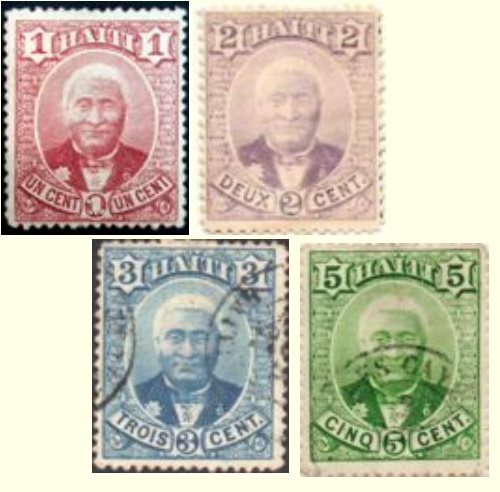
The long-running Palms issue with values of 1, 2, 3, 5 and 7 cents was printed on various papers in France between 1891 and 1898. Interspersed with these was a printing by the London firm of Skipper and East in 1893. The first Palm "Coat of Arms" issue was produced in 1891. This five stamp set has the leaves on the tree raised in this issue, which is a distinguishing feature for these stamps.

A six stamp set was issued in 1892-95, this time with the leaves "dropping". The stamps were produced with a combination of engraving and lithography.
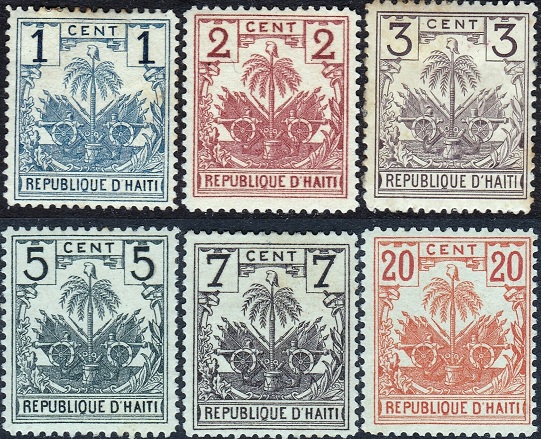
In 1898 a new issue featured a more complex Palm design. Some of these issues have mixed perforations. There is a POST PAID handstamp but the reason for it is not known.
In general, material is very difficult to find. Generally, Presidents did not last long, and at least one was deposed before the stamps that he had ordered had arrived - but his stamps are known on cover! The 1893 Skipper and East printing was not paid for, so they refused a request for a further printing, and that work was carried out in France.
The 1898 issue was printed locally but eventually printing was moved to the American Bank Note (ABN) Company. The ABN issue was later overprinted to fix a shortage of 2c values. The issue was also forged. In 1904 there was a special issue for the Centenary of Independence (after 102 years).
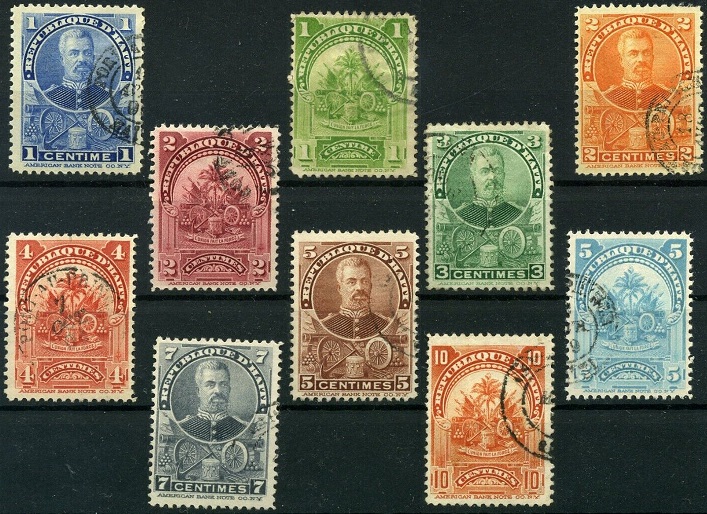
There were different stamps for internal and external currency. We were shown a sheet with stamps every which way and with a forged overprint. In 1906 ABN printed a further new issue and Postage Dues appeared for the first time. These were also overprinted.

In 1910 there was a new President and new values, followed by a further new set with new values in 1913.
In 1914 the President was again overthrown and stamp were re-issued with different centres. In 1915 there was another new President, but his stamp order was stolen whilst it was on board ship and never issued.
From 1915 to 1934 US Marines were on the island and they used their own Postal System. From 1926 they created fancy cancels for Air Mail.
On Haiti there are few roads, and most mail travels on coastal steamers.
Basil Lee Rowe owned and operated West Indian Aerial Express. This was an early airline that flew between Cuba, Haiti, Dominican Republic, Puerto Rico and the U.S. Virgin Islands starting in July 1927 and ending in late 1928. The service carried both passengers and cargo. On 14th July 1927 the trial flight by WIAE pilot Max Marin was made from Barahona, Dominican Republic, to Port-Au-Prince, Haiti. Postage of 2 centavos per ounce was charged. There was no extra fee for air mail. After around nine months of operations the WIAE was sold to Pan American World Airways due to a hurricane destroying or damaging its entire fleet of 3 aircraft. Pan Am even took over the WIAE's owner and chief pilot, Basil Rowe, and made him their chief pilot since he knew the routes and the government officials in those other countries. We were shown First Flight Covers Haiti to Venezuela and Jamaica to Haiti.
In 1939 stamps were issued for the Olympic Games that did not take place (the stamps included an extra amount to raise funds for the building of a municipal stadium in Port-au-Prince) and in 1945 a Red Cross set was issued followed by a TB relief set in 1949.

During the 1950s many stamps were issued along with five Miniature Sheets. In 1950 an overprint was issued to celebrate the 75th Anniversary of the UPU. Amongst the 90-plus stamps issued by Haiti in 1969, a set of Butterfly stamps issued in November 1969 is, apparently, scarce.

In 1976 an issue was made for the 200th Anniversary of the American Revolution. Finally, in 2010, Haiti ceased to issue stamps.
Patrick Reid thanked Geoff for a truly remarkable display of material that most attending had probably never seen before. It was both educational and enlightening, and clearly a good eye for forgeries is needed.
12th April 2022 - Informal Cinderella and Postcard Competitions
The first part of the evening was the competition. There were three entries in the Postcard class and two in the Cinderella class. All were judged by those attending. The Postcard entries were:
- The British Empire Exhibition by Michael Curling
- The 1906 Halifax explosion by Alan Matheson
- The Green of Rhodesia by Trevor Cornford
The Cinderella entries were:
- TV Licence Stamps by Chris Rayner
- TB Charity Labels by Trevor Cornford.
The Postcard winner was Alan Matheson, and the Cinderella winner was Chris Rayner. Chris Rayner's entry was also awarded the "Best in Show" prize. The winners received suitable Certificates.
Thanks to our entrants for taking the trouble to prepare exhibits.
The second part of the evening was filled by displays from members who had brought material to display.
Eric Holmes showed "A pot-pourri of Cinderellas" including:
- Parcel Post labels
- Bills of Exchange
- Duty Stamps
- Court documents
- Exhibition Souvenirs from 1970 and 1980
- A Savings Bank book
- A permit to allow access after a gate had been locked
- A South African Death Duties document granting exemption from Duty.
Derek Steele displayed some Newfoundland stamps, notably the 300th Anniversary of colonisation issue that had many errors in the printing (for example NFW for NEW).
Trevor Cornford showed British Antarctic Survey postcards, issued in a series numbered BAS-01 to BAS-60. His set is complete except for numbers 12 and 43. He noted that rats and reindeer had been removed in the 1980s as they were upsetting the local eco-systems. Some cards were used and carried at a special Surface Rate. There were a number of cards from the R.R.S. John Biscoe and others featured ships, planes and wildlife.
Patrick Reid showed a few Tasmania postcards, explaining that they were a "trailer" for a full display of postcards of "A trip around Tasmania".
Finally, Mark Bailey showed a range of souvenirs from Exhibitions and Shows. These were from Barcelona, London 1990, Espana '82 (coinciding with the football World Cup), Israel 1998, Glasgow 2000, Grocers and Allied Trades 1939, New Ideas Exeter 1938, Lyon 1970 Fair, and Madrid 1970 International Camping Exhibition. Mark also displayed labels from Gairsay (in the Inner Hebrides), the 150th Anniversary of Tasmania, the Junior Philatelic Society (later the National Philatelic Society), and an Eynhallow stamp with a perforation shift. Revenue items included Spanish Hospital Tax and Danish Cigarette Tax.
Patrick thanked all who had entered the competitions and all who had displayed, contributing to a varied and interesting evening.
22nd March 2022 - Mexico: Postal Cards & Mexican Revolution - David Walker
We were entertained by our member David Walker, who displayed Mexico Postal Stationery covering the period 1882 to 1900. David explained that the items bore different styles of an eagle that changed regularly. The stamps were either embossed or imprinted, and a "Franco" cancel means the item has been paid.
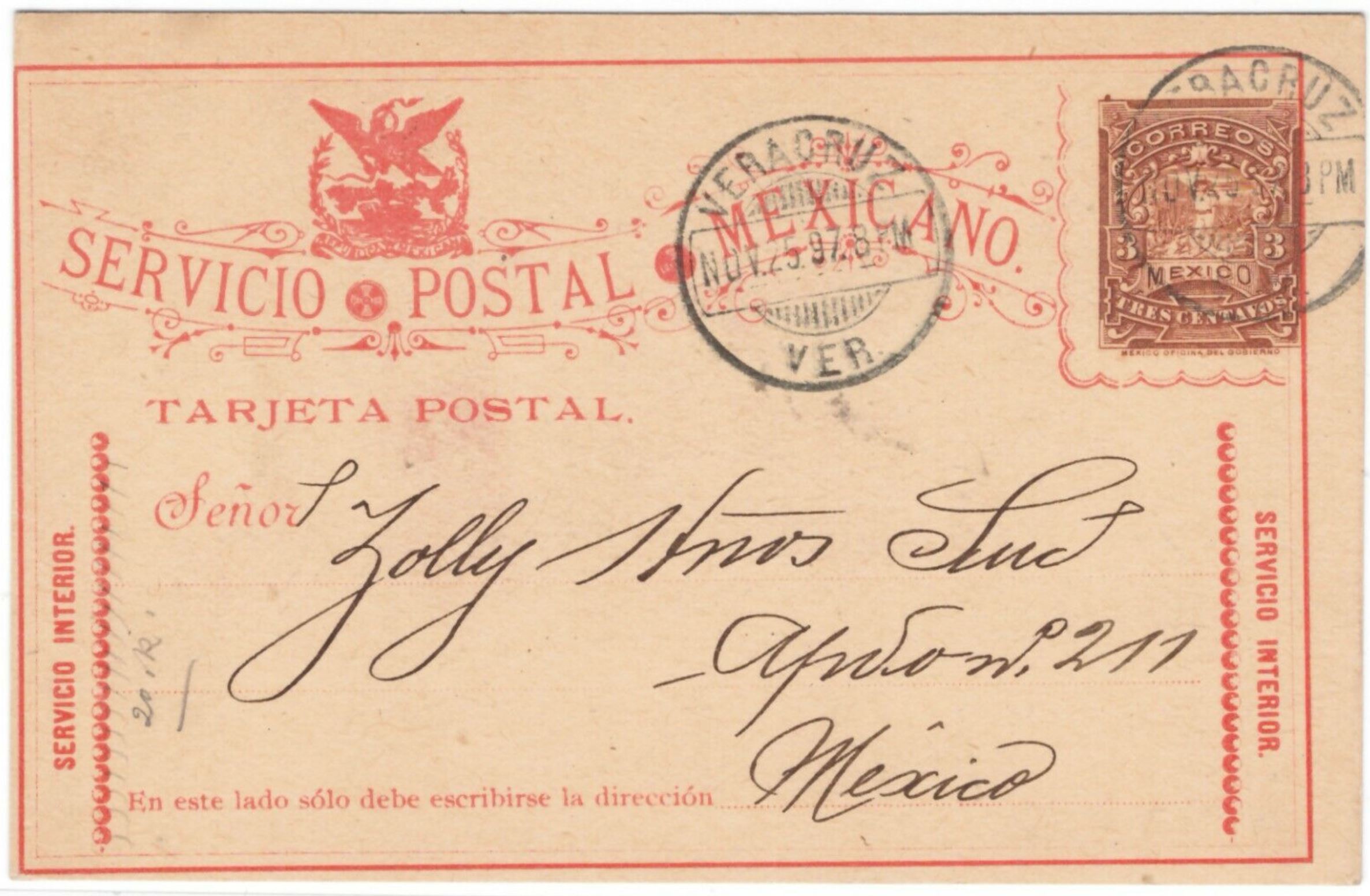
The items shown were a mix of Letter Cards and Reply Letter Cards, addressed to a good range of destinations. Some of the items had been uprated, and much that was sent overseas was addressed to Germany. This is no great surprise, as German collectors went for Postal Stationery in a big way.

The position of the eagle varied, but it was usually on the left (as viewed from the front) or in the centre. The denominations were normally 2, 3 or 5 cents or pesos whichever was in use at the time. To give some variety we saw envelopes printed by Waterlow and letter cards with either stapled or gummed sheets in the centre that could be used for correspondence. To comply with UPU Regulations, items for international use bore inscriptions in both Spanish and French.
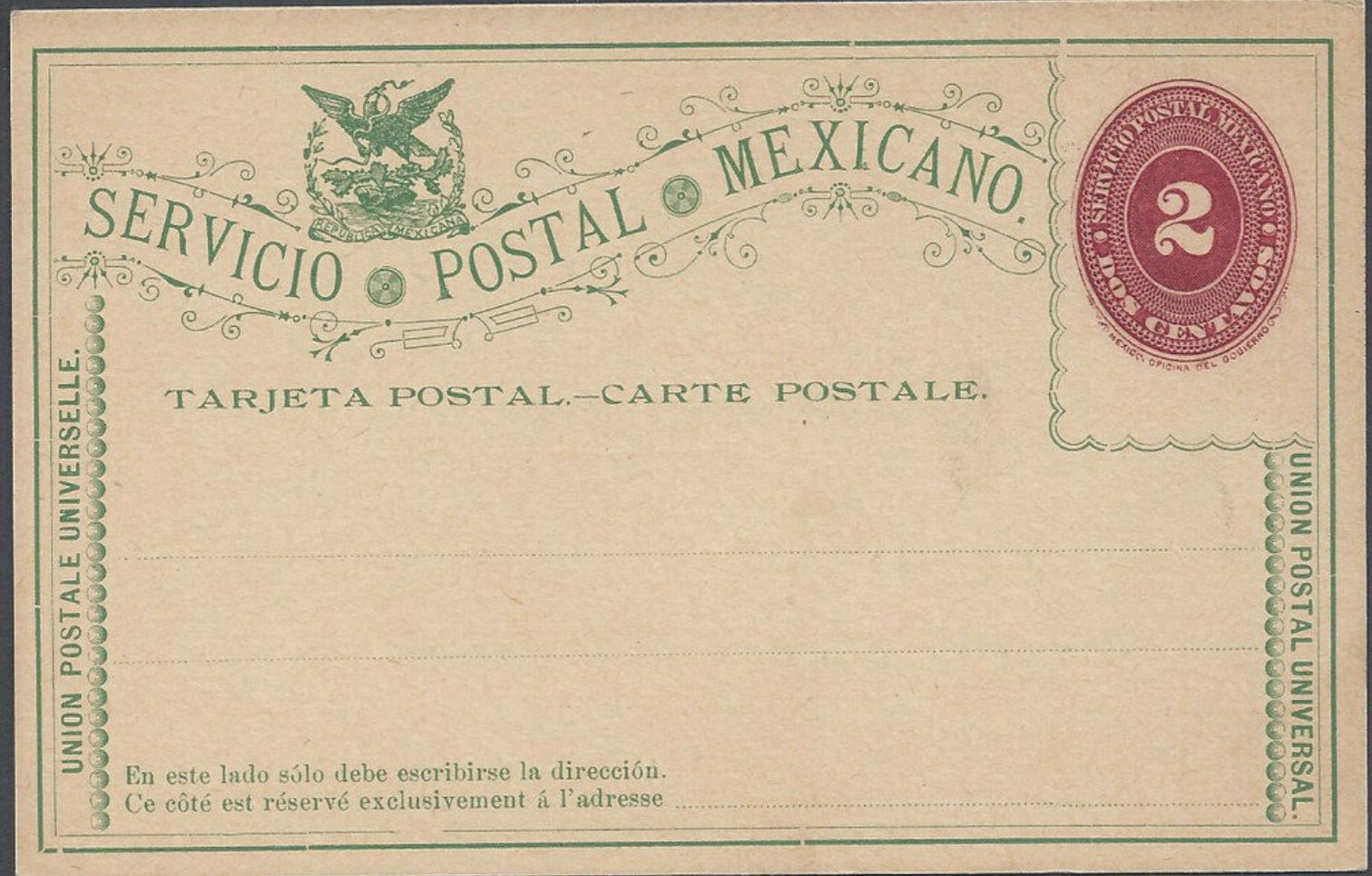
We were also shown elongated style envelopes printed by Waterlow that were designed for overseas use, with a registered cover sent to Russia.

The second half of David's presentation looked at the Revolution in Mexico between 1910 and 1920. There were three parties involved, all vying for power: The Federales (Government), the Bandits and Texans trying to annex land. From this period we were shown a wooden postcard that had been through the post.
Next came a letter card by Bradbury Wilkinson, both mint and used, and a Specimen in which the value had been blocked out.
It was noted that Customs had their own "Frank Stamp" to prepay postage and we also saw examples of Fiscal stamps used for postage, both domestic and overseas, stamps overprinted "GOBIERNO" on a cover to France and Army Issue envelopes with bisects applied. There was also a letter opened by Customs and resealed. It was noted that some States issued their own stamps in time of shortages.
Perhaps reflecting the chaotic times of a Revolution, it was noted that there was a great deal of unclaimed and/or Return to Sender mail. Thus for instance, a letter advising of the death of a soldier in a mourning envelope had been returned to sender.
Sets of stamps issued in 1910 were shown, together with usages on cover followed by wrappers both mint and used. Revolution stamps were issued in 1915, and these were later surcharged. Use on cover was shown, as were examples of Railway Cancels. The final item was a 1920 Registered cover to Mexico City.
Patrick Reid gave the vote of thanks and complimented David on the range of interesting material that he had shown. It should provide a good basis for research to find the stories behind the Revolution.
8th March 2022 - On the topic of Centenaries and Birthdays
Members were entertained by a short series of small displays on the topic of Centenaries and Birthdays.
The first display was by Michael Curling, who had brought a range of items relating to Kew Gardens. These included some First Day Covers, Presentation Packs and Special Postmarks.
Ivan Dickason followed, and showed:
- Barbados 500th Anniversary set, including varieties
- Bahamas 1952 Centenary of Stamps
- Hong Kong Centenary of British Occupation
- Malta Centenary of Stamps
- St Helena Centenary of Stamps and the Tercentenary set
- Trinidad & Tobago War Stamp and overprints.
Brian Pugsley showed:
- The Tercentenary of Bahamas Settlement
- 1492 Landfall of Columbus including overprint varieties and a double overprint. Also a Columbus variety in blocks and a forgery.
- Some German Propaganda overprints.
Roger Sammons displayed WWI and WWII commemorative stamps from France in booklets.
Chairman Patrick Reid thanked all who had brought something to show.
8th February 2022 - On the theme of Sports and Entertainment
Members were entertained by a short series of small displays on the theme of sports and entertainment.
Michael Curling brought along an interesting series of postcards relating to exhibitions, at which the visitors would have been entertained by the wealth of items exhibited. The postcard were for events held in the period 1901 to 1910 inclusive, and included the following exhibitions:
- The Glasgow International Exhibition of 1901, an amazing demonstration of Victorian self-confidence which proudly displayed the great progress made in industry, science and art during the 19th century. The exhibition was officially opened on 2nd May 1901, and it ran until 9th November. The Glasgow exhibition had displays of fine art in the City's new art gallery, a highly ornamented industrial hall for industrial exhibits, exhibitions featuring countries with close ties to Glasgow, and entertainment, including a switchback railway, and a water chute. It was extremely successful, attracting around 11.5 million visitors.

- The Wolverhampton Art & Industrial Exhibition, May to November 1902. Many important artworks were on display at the exhibition. The exhibits in the Industrial Hall consisted of displays by British manufacturers, including ironwork, safes, silverwork, glass, upholstery, paint, bicycles, and even a display by Heinz, featuring soups, baked beans, and tomato sauce, which visitors could sample. Other items on display included cycles, safes, locks and door furniture, fencing and gates, and gears. There were also some exhibits from abroad including carvings from India, and arts and crafts from Japan.
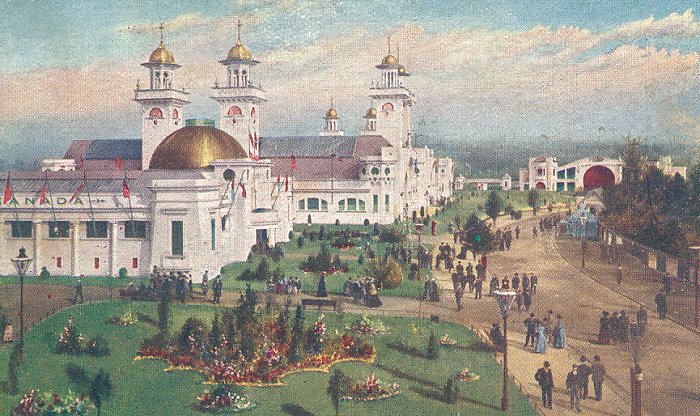
- The Trent Bridge and the Midlands Industrial Exhibition, Nottingham, 1903-1904. The Midlands Industrial Exhibition stood on the banks of the River Trent for little more than 400 days, before being destroyed by fire. Along with the Industrial Hall was the Mughal (Indian) style, steel-framed two-storey main building named the Ivory Palace, displaying goods from around the world and a funfair with Canadian Water Chute, an American roller-coaster and the Fairy River that took visitors through caverns past walls set with magical scenes and down a lane of stalactites. On the night of 4th July 1904 an electrical fault in one of the Fairy River caverns sparked a blaze that engulfed the entire exhibition.

- The Naval, Shipping and Fisheries Exhibition held in Earl's Court, London in 1905. This was intended to mark the 100th anniversary of the Battle of Trafalgar. Trafalgar-related items included an item labelled as the quilt from Nelson's bed on board ship and a "scenic interpretation" of the battle and death of Nelson. However, in addition to Trafalgar commemoration, there were naval, shipping and fishery related exhibits. The naval-related exhibits included Captain Cook's chart rule and his plane table, fishing displays included the opportunity to observe fishermen mending nets and divers in a diving tank, and shipping-related exhibits included an 8ft model of the Empress Queen and a village of American Indians in which war canoes were shown. More actively there was the opportunity to take a submarine trip, and there were amusement rides including a Hiram Maxim Captive flying machine, the Great Wheel (a 310 ft tall Ferris wheel), and a Shoot-the-Chutes.
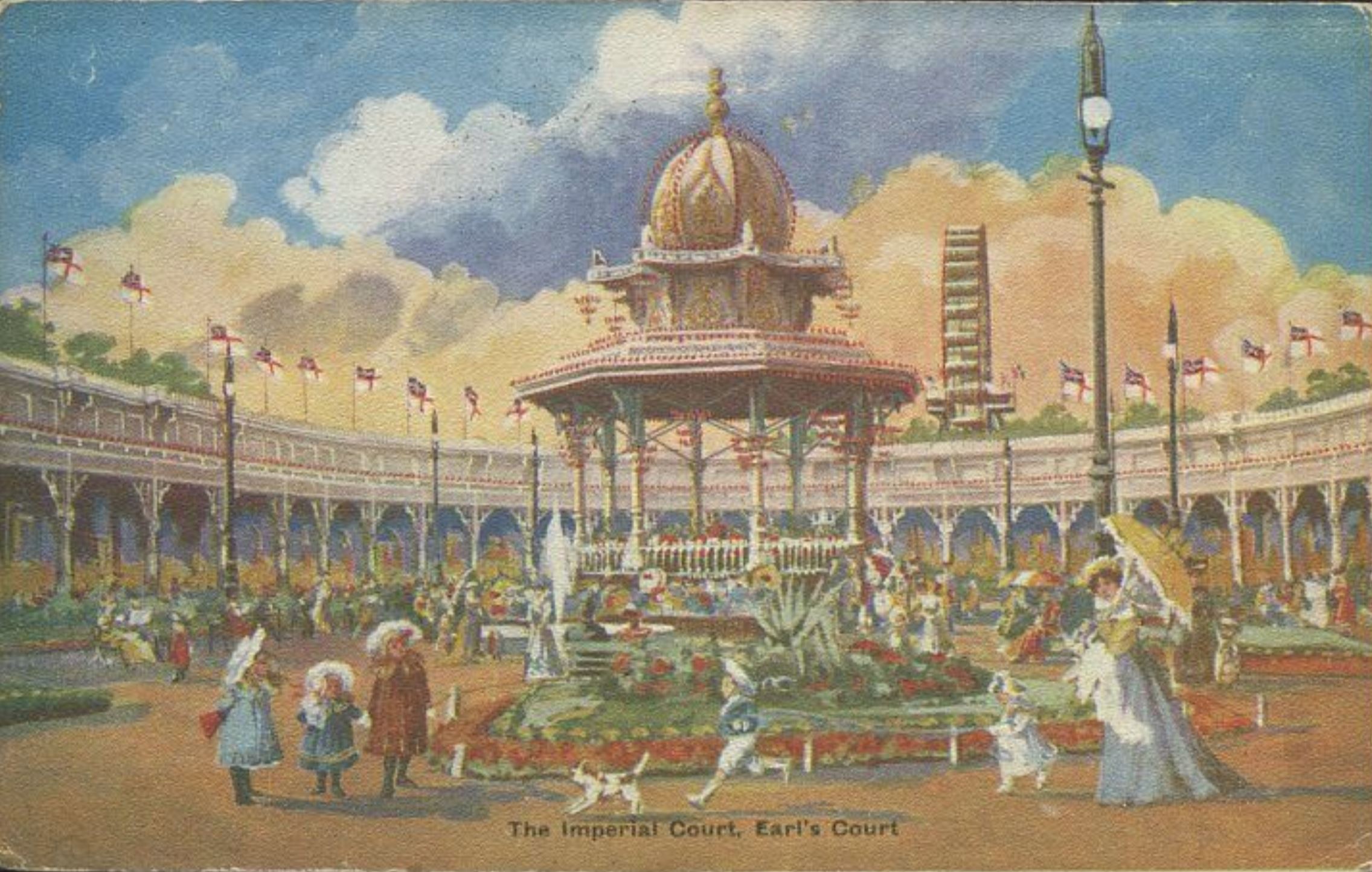
- The Imperial-Royal Austrian Exhibition, held in Earl's Court, London from 20th June to 6th October 1906. Three aspects of Austrian society were explored in different themed areas. There was a "Tyrolian Village" with lacemakers, woodcarvers, beer halls and cafes, a model underground salt mine reached by a slide, and a Bohemia area. There was also an Austrian restaurant. The exhibition was the last use of the Great Wheel.

- The Irish International Exhibition in Herbert Park, Dublin, which ran from 4th May to 9th November 1907, and received 2.75 million visitors. As well as contributions from countries including Canada, France, and New Zealand there were displays of motor cars, electric and gas lighting and machinery, fine art displays, and funfair amusements.

- The Franco-British Exhibition held in London between 14th May and 31st October 1908. The exhibition attracted 8 million visitors and celebrated the Entente Cordiale signed in 1904 by the United Kingdom and France.

- The Scottish National Exhibition, held in Saughton Park, Edinburgh from May to October 1908. The main buildings comprised the Industrial Hall, Machinery Hall, Fine Arts Gallery, Concert Hall, Canadian Pavilion, and Winter Garden. Besides these there were Russian and Irish pavilions, a Model Hospital, Small Holdings, Refreshment Saloons, Band and Grand Stands, and Kiosks. A popular amusement was the water shute, having a switchback descent. The Helter Skelter, 'Hall of Laughter' and Spider's Web and Maze afforded endless amusement, and there was also a switchback railway in the form of a figure of eight, and revolving airships.
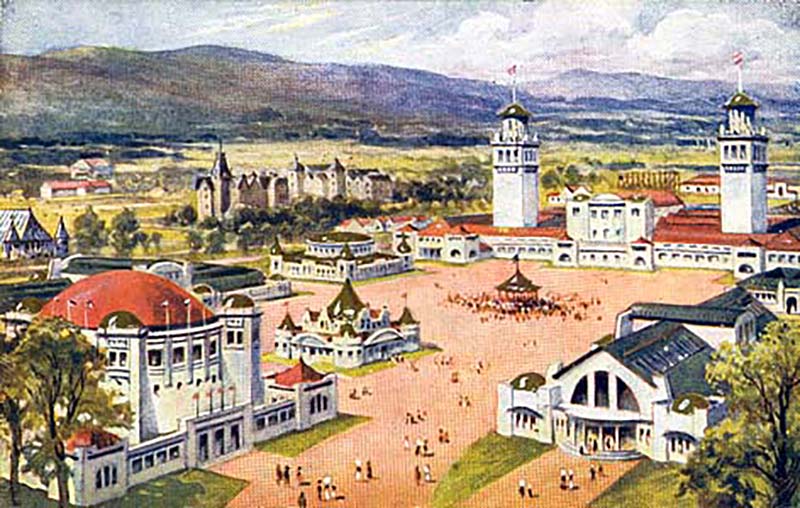
- The Imperial International Exhibition, held in White City, London from May to October 1909, at which Austria, China, Denmark, France, Italy, the Netherlands, Persia, and Russia also participated. The amusements included an alpine railway.
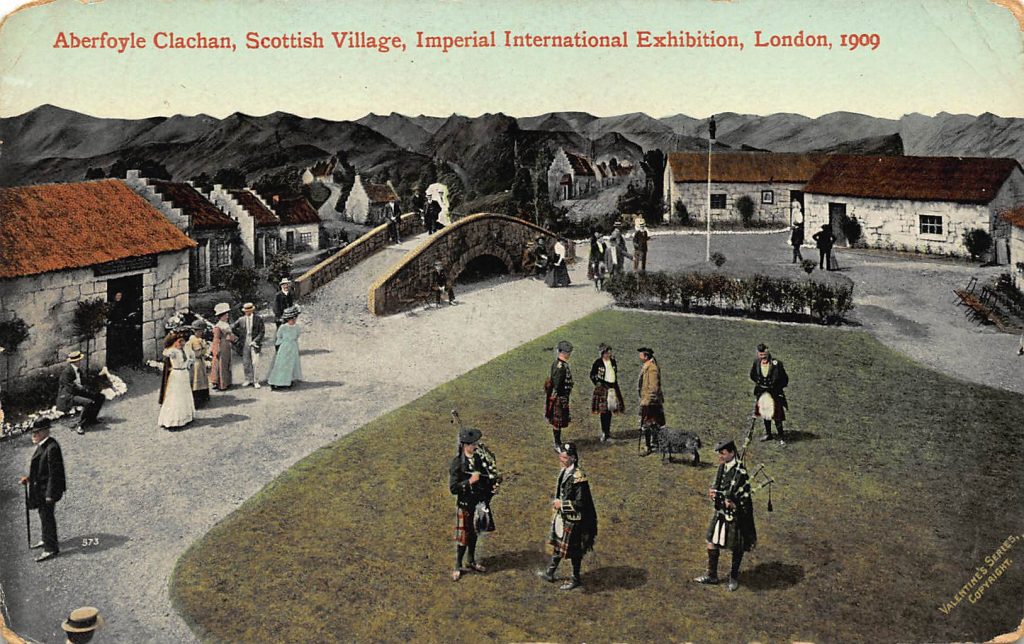
- The Japan-British Exhibition, held at White City, London from 14th May 1910 to 29th October 1910.

Trevor Cornford displayed Antarctic sports, including sledging and football on ice, as well as gas ballooning.
Eric Holmes and Mark Bailey each showed a souvenir cover relating to sports. Eric displayed a Manchester United Centenary Season commemorative cover from 1978, and Mark displayed a Papua New Guinea first day cover for the 1975 South Pacific Games held in Guam.
25th January 2022 - Material Obtained in 2020-2021
Members were invited to display new items that they had acquired in 2020/21.
Roger Sammons showed various unusual items:
- Sharjah postally used stamps that are not listed in the Stanley Gibbons catalogue
- King George V Silver Jubilee stamps with "surprise" varieties
- New Zealand stamps also with varieties
- items from kiloware with missing gold and/or green/gold and others with varieties
- A Gibraltar stamp with inverted watermark
- some John Farleigh sketches, possibly original artwork.
Trevor Cornford showed material mostly with a polar flavour:
- a Falkland Islands pair of stamps with a bisect on one stamp, postally used
- an RRS Discovery letter to Edinburgh
- a picture of the Royal Yacht Duke of Edinburgh
- a calendar illustrating the SS Great Britain
- Ceylon Queen Victoria postal history and stationery
- a North Pole publication
- a relevant Boys Own Paper
- two press cuttings about the River Swale Bridge.
Michael Curling showed a range of material, most with local interest:
- a letter to India franked with 5 x ½d Queen Victoria stamps cancelled at "Wellington College Station" (now Crowthorne)
- King Edward VII stationery and a Parcel Label, both with Wellington College Station cancels
- a postcard of Crowthorne and a train postcard cancelled in Crowthorne
- a Registered cover cancelled at the Royal Military College, before it became the Academy
- a 1d Black with variety
- a College Town Parcel Label
- a postcard of Finchampstead Post Office
- some Railway parcel stamps
- a Cunard label
- an Isle of Wight telegram
- an AR (Avis de Reception) stamped form
- a Victorian era Savings book.
Eric Holmes told the story of the civilian evacuations of Malta and Gibraltar during WWII. The Maltese refused to be evacuated. Gibraltar was evacuated to Casablanca but returned to Gibraltar when the Vichy Government was installed in France. Gibraltarians were then moved to the UK and subsequently to Madeira and Jamaica. Eric showed a selection of postal history from the Jamaica camp, which had its own handstamp, but all mail went through and was cancelled at the Kingston GPO. He believes it may be possible to establish who was in each hut of the camp.
Ivan Dickason showed some more from his ½d collection. He began with a block and a sheet of the Iraq quarter anna, followed by ½d stamps from Turks & Caicos (1935) and Northern Rhodesia. He ended with Official and War Tax overprints from Trinidad & Tobago and finally some South West Africa 1d overprints.
Brian Pugsley completed the first part with some items from his King George VI collection, including varieties from Bahamas (misplaced overprint) and Northern Rhodesia; proofs of the 15 cent from Kenya, Uganda and Tanganyika, and Harrison printings of Mauritius.
David Walker opened the second half with material relating to the 1910-12 Japanese Antarctic Expedition. The early material was complemented by Anniversary covers from the 1960 Expedition.
Mark Bailey stayed with the polar theme showing a card from the US South Pole base, but then moved close to home with a card showing the Finchampstead Post Office in 1906. Mark then showed further material from his George Campbell collection, much of which relates to the Channel Islands. He began with a correspondence card sent from Vienna to Paris in June 1881 concerning the placing of an advertisement in a philatelic magazine, and the associated advert, followed by a letter from Constantinople to Jersey. Next came a letter from Jersey to London written to the dealer/publisher Hellier.
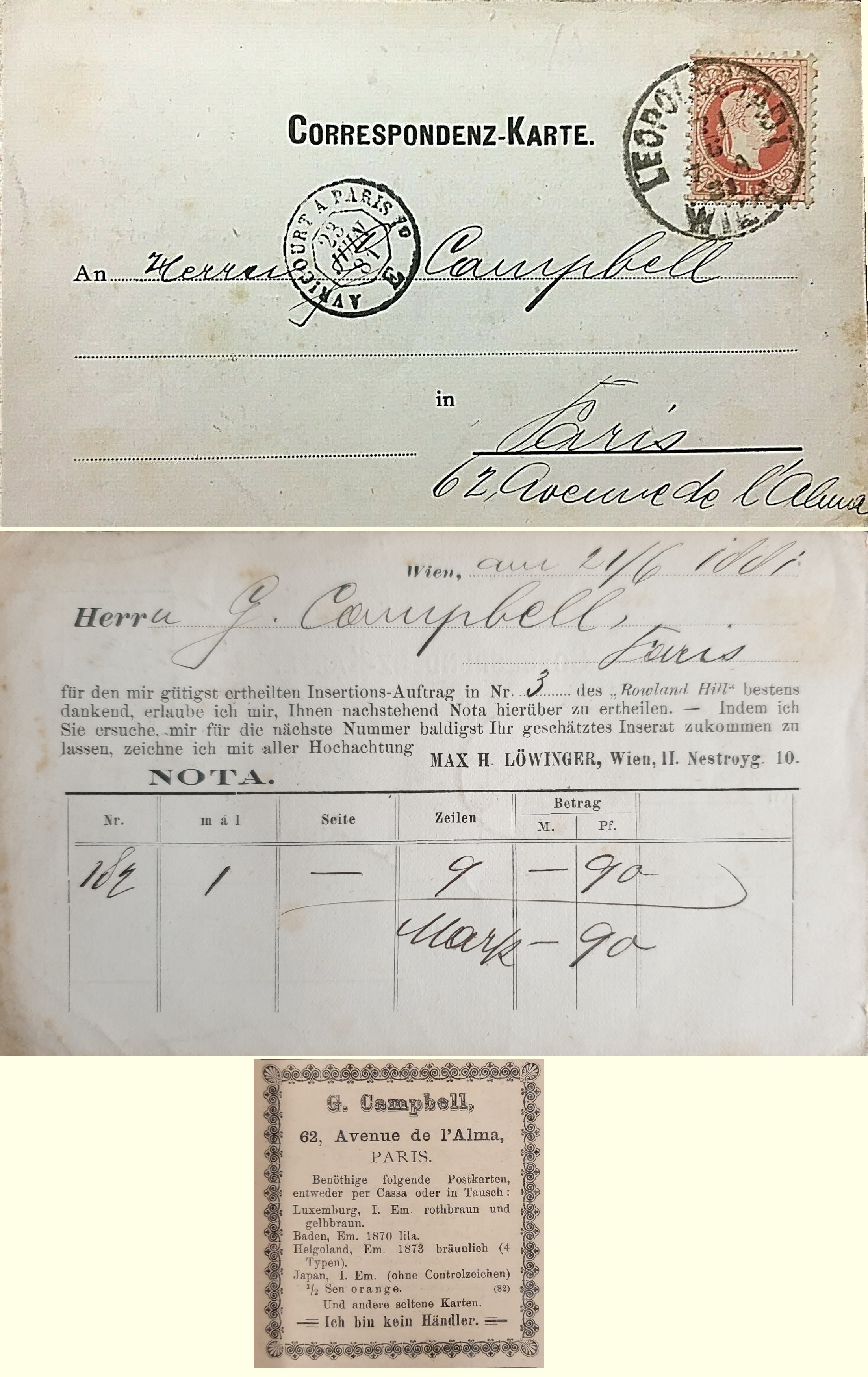
Around 1901 Jersey tourism was developing and Mark showed some holiday labels, including one on card. Next came a 1901 card from Sark to Mauritius and a 1905 letter sent from the Grand Hotel in St Helier referring to the owner of Herm. This brought him to the final section relating to his holiday in 2021 on Herm and Sark. On 10th May 2021, Guernsey Post issued a set of 6 stamps to celebrate the tenth anniversary of Sark being designated the world's first Dark Sky Island, very good for astronomical observations. He showed the stamps, a hand cancelled cover, photos and a map of the locations from which the star photos featured on the stamps were taken.
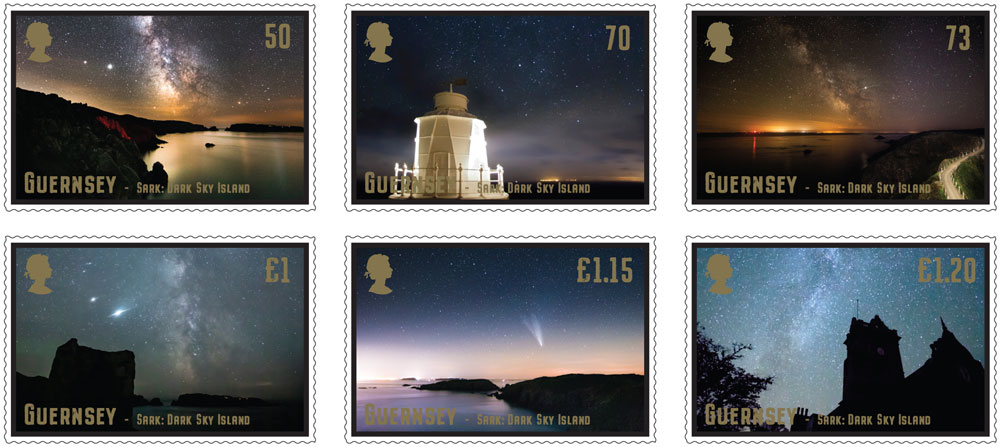
Last to show was Patrick Reid. He had brought some very scarce embossed Tasmanian Newspaper Wrappers in the three available denominations: 2d, 3d and 6d. These were followed by new material for his Frank Stamp collection including a letter from the Bishop of Tasmania, covers from the Government Statistician, and rare stationery printed for the 1891-2 International Exhibition in Launceston. He ended with a postcard of a traction engine towing a trailer to move the Methodist Church in Cressy in 1915.
Patrick Reid thanked all who had brought material, which was varied as always, and wished everyone a safe journey home.
11th January 2022 - Chairman's Evening
The Society's Chairman Patrick Reid showed his display entitled "Tasmania - The Rise and Fall of the Frank Stamp System 1883 - 1902". Unusually the whole display was on A3 pages.
The opening section outlined the structure of the display and explained that the signature-based "FREE" mail system was being abused and a more secure system was sought for mail sent "On Public Service Only". The adopted solution was to issue each Government Department with a "Frank Stamp" that took the place of a Postage Stamp. There was a nominated "keeper" in each Department through whom all outgoing mail was routed. The keeper was responsible for applying the Departmental Frank Stamp to the mail and putting the mail into the system. Limited use of the signature-based system was still allowed.
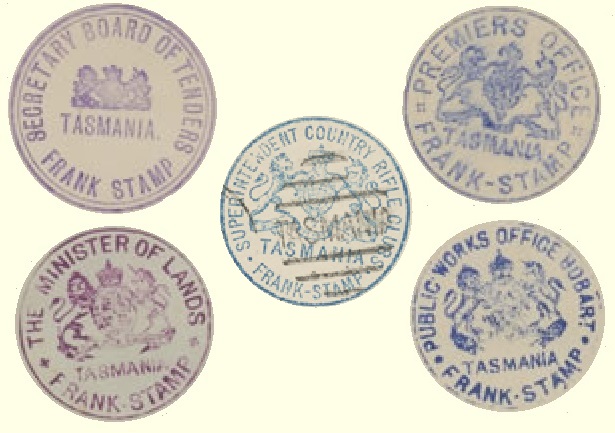
Strictly, envelopes were not allowed to be pre-stamped, but this rule was bent for practical reasons. For example the Headquarters Defence Force had offices in several places in the colony, so a supply of pre-franked envelopes was made available to each.
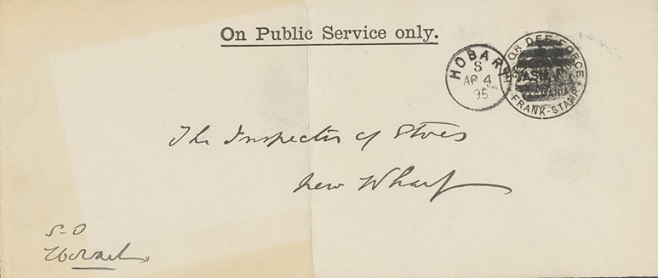
The second section of the display showed the various Frank Stamps for each department, in chronological order of issue. All are basically circular and most contain the Arms of the Colony and the name of the Department. They are classified into types, and Patrick explained the types and sub-types. Only the Governor's Frank Stamp had a moveable date.

The main section showed posted material from each department. Patrick explained that the material available is mostly from a limited range of sources from which correspondence has "escaped". These include The Colonial Storekeeper, Walch & Son, Printers and Stationers, various firms of Solicitors, notably Miller & Miller, the Smith Correspondence (a well-known Tasmanian resource), and The Rev. Philip Edwin Raynor, Warden of Christ's College, who was also a noted Tasmanian philatelist.

The first Frank Stamps were issued in 1883 to eight Departments and subsequent issues were made as the need arose. If a Frank Stamp became very worn or damaged, it was either repaired or replaced. Over the life of the system a total of 56 different Frank Stamps were issued and examples of all were shown. There is one that has not yet been found on cover. Its existence is known from the records of "Proof Strikes".
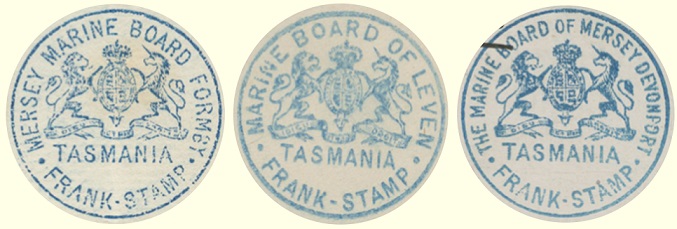
The display was interspersed with postcards and other illustrations showing the exterior and interior of various departments and pictures of relevant important people.
Tasmania held two important International Exhibitions in Launceston in 1891-2 and in Hobart in 1894-5. The Launceston event used the Corporation of Launceston Frank Stamp but had its own Stationery.
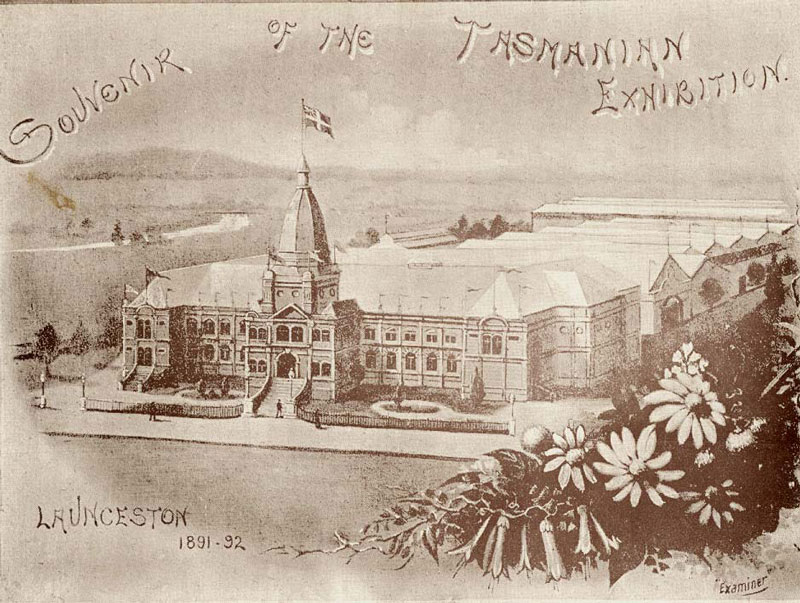
The Hobart event had its own Frank Stamp and Stationery, and the Stationery postcard was specially overprinted too. A picture of the Hobart Exhibition Pavilion was shown. It had been built of wood and was dismantled and stored in a wood yard. Unfortunately there was a fire on 5th November 1909 (possibly caused by a stray firework) that destroyed the pavilion. A postcard was shown of the remains.
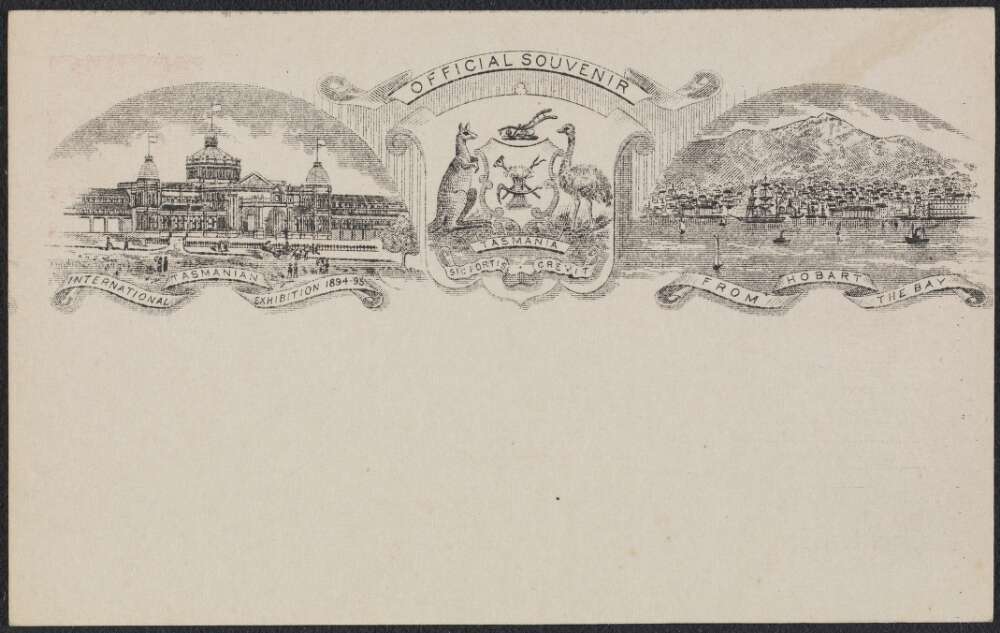


A few unusual uses were shown towards the end of this section, including two large covers from the Admiral Commanding the Australian Squadron, who was entitled to the free privilege and a covering letter under which the Stipendiary Magistrate, Ringarooma returned his Frank Stamp when the system was ended in 1902.
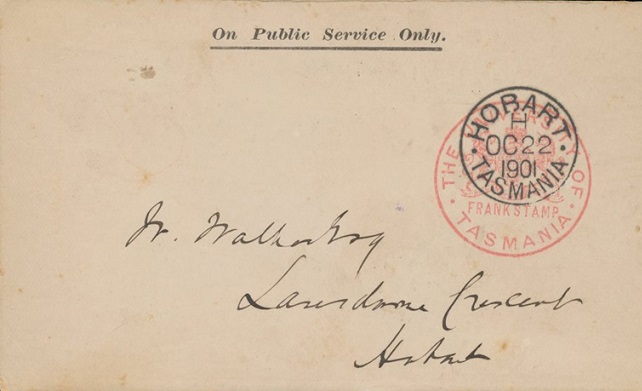
The final section of the display showed what happened next. All Frank stamps were withdrawn in 1902, with the exception of the Secretary General, Post Office, which continued in use occasionally until 1904. Frank Stamps were no longer required as they were replaced by perfins on Tasmanian stamps. National Government Departments used stamps perfin "OS" and Tasmanian Government Departments used stamps perfin "T". Examples of these used on cover were shown.
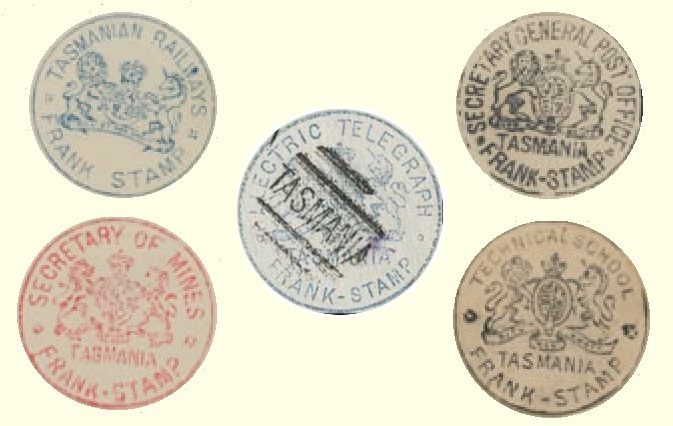
Patrick's final item was a very large cover (Size K: 377x164mm) that had been used in 1901 to return ballot papers from Queenstown to Hobart. It had been endorsed with the signature handstamp of George Crosby Gilmore, formerly the Member of the House of Assembly for George Town. However, he had retired in 1900 so was no longer entitled to use the privilege. The cover has been endorsed "Irregularly Franked / Deficient Postage 1/9 / Fine 1/9 / 3/6 to Pay" It is unclear whether the government charged itself, but the cover is a remarkable survivor and only the second recorded Taxed Frank item that Patrick has seen.
